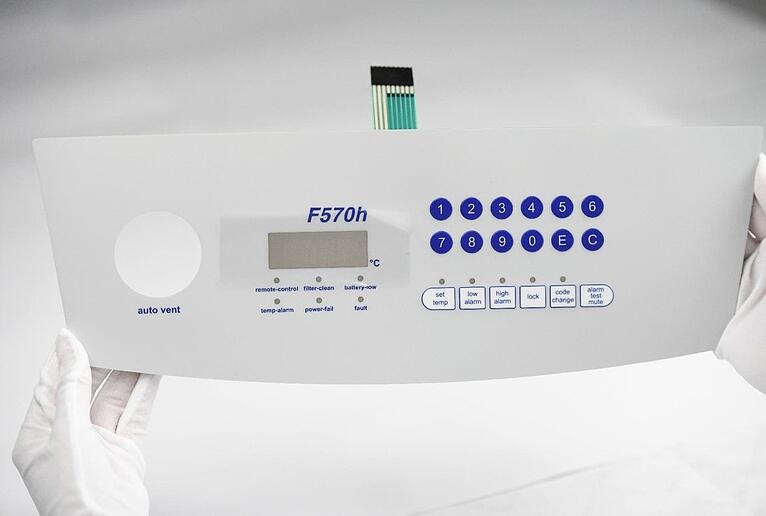In this second article about Quotation Checklist we will look specifically into Membrane Switches.
Many of our customers request a price estimate with only a vague description of what they want. This article lays down the most important information required to provide an accurate pricing of your membrane switch.
Tactile/Non-Tactile
First we need to know if a tactile response is desirable. In a non-tactile solution, when the user pushes a button there is no direct sensitive feedback, similar to touching the screen of a smartphone (with the haptics turned off).
Tactile constructions, on the other hand, are designed with metal domes or polydomes, which provide immediate tactile response. As far as it’s possible it will help to know the type of domes and/or the needed tactile force.
Customers usually also specify the embossing shape, size and height.
Construction
The buildup of a membrane switch is rooted in the company experience, capability, equipment and people. Some customers are rigid about the construction of their product but more often than not the responsibility of stacking up the various layers lies with the manufacturer. We need to know upfront whether the customer intends to dictate the construction or rely on our expertise. The features that we would need to know include:
- Materials: nature, thickness and properties.
- Composition: single-sided, double-sided, stacked-up double sided etc.
- Layering: switch foil, rear adhesive, dome retainer, overlay adhesive etc.
- Circuitry: circuit density, line and space, through holes vias etc.
Lighting
Recent developments in light guide material provide innovative solutions for a uniform backlighting using a limited count of side-firing LEDs and guide foils that are designed to evenly distribute light. Traditional lighting solutions employ discrete LEDs with locations and colors to be clearly defined.
Color
A critical component of a membrane switch is the graphic overlay, as it is the surface that the customers will see and touch first. It has to be cosmetically pleasing, technically sound and user-friendly, all at the same time.
Color, finishes and texture are important elements of a company branding and we expect the customer to always provide his requirements.
Display window
The display window consists of a clear area on the graphic overlay typically used to read the LCD screen. It is customary that the client specifies the material and its properties.
Shielding
ESD shielding is a common solution to protect electronics components from electrostatic discharge. It can be printed with conductive inks or be inserted in the construction as an aluminum coated foil. It all depends on the customer applications and limitations.
Certain applications also require EMI/RFI protection.
Connectors
Ultimately the membrane switch needs to connect to something and the customer is the only one to know. Guessing is not an option.
One of the most common and recommended solutions is a ZIF (zero insertion force) connector. If you chose a ZIF connector we would need to know the tail pitch. Mechanical Crimping is also very popular and Central Midori carries the major brand of crimping machines. Recent development in Z-Axis adhesive offers a cheap and quick way of connecting a membrane switch to a PCB.
Mechanical Dimensions
Our production takes place in sheet form which means that our engineers have to do the panelization first. The panelization consists of laying out multiple single parts on a standard sheet size. For example, if your product is sized 8in X 4in (200mm x 100mm) we can probably fit 6 parts on a 16 X 20in panel (400 x 500mm). One single part is therefore charged for ⅙ of the cost of processing one sheet.
External dimensions don’t have to be very precise, +/- 0.1in (2.5mm) are good enough.
However, tolerances are important, as they will dictate the type of tools and equipment to be used.
Sealing effectiveness
Finally we need to know if the product has to be dust or water proof. An IP Rating (Ingress Protection Rating) is the rating used to classify the different levels of sealing effectiveness provided by an electrical enclosure against foreign bodies such as objects, water, dirt, etc.
Upon request, our membrane switches can be designed for IP67 environment protection certification.
Testing
On demand we offer testing and inspection services including but not limited to 3D measuring, dynamic testing, electrical and functional testing, temperature and humidity cycling, dome actuation life testing. All of our testing protocols are personalized and follow customer’s requirements.
Conclusion
We understand that some of our customers are still uncertain about their requirements and we are pleased to offer what we call “our industry recommendations” to help them make their decisions.
Central Midori has been producing Membrane Switches for more than 30 years for Medical, Industrial, Instrumentation and Consumer Electronic markets. Our customers are In Asia, Europe, Japan and North America. Please feel free to contact us by email, centralmidori@central-midori.com.sg or through our website: https://centralmidori.com/contact/

